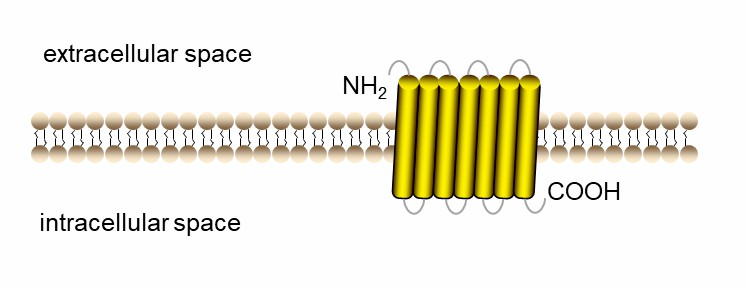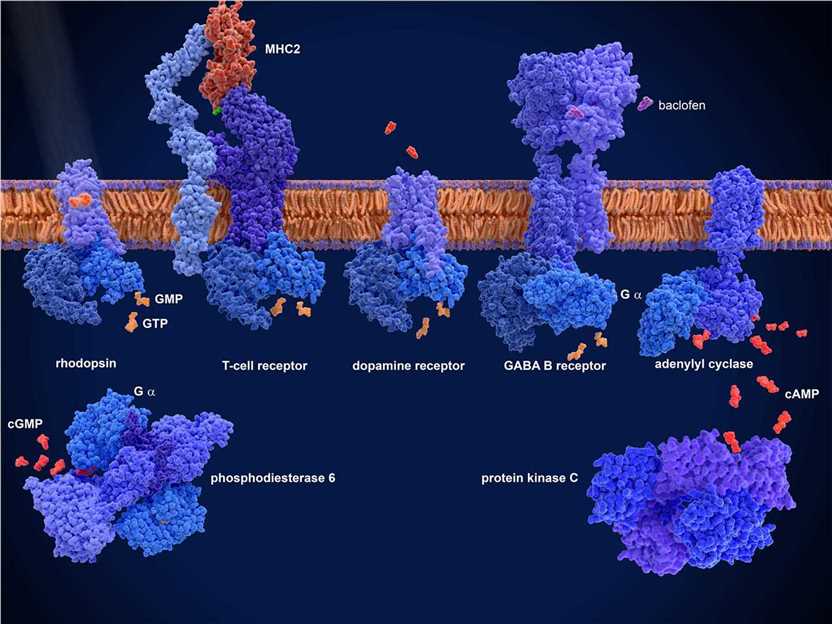G Protein-Coupled Receptors (GPCRs)
About G Protein-Coupled Receptors (GPCRs)
G protein-coupled receptors (GPCRs), also known as seven-(pass)-transmembrane domain receptors, 7TM receptors, heptahelical receptors, serpentine receptors, and G protein-linked receptors (GPLR), form a large group of evolutionarily related proteins that are cell surface receptors that detect molecules outside the cell and activate cellular responses. They are coupled with G proteins. They are all activated by agonists, although a spontaneous auto-activation of an empty receptor has also been observed.

G protein-coupled receptors are found only in eukaryotes, including yeast, and choanoflagellates. The ligands that bind and activate these receptors include light-sensitive compounds, odors, pheromones, hormones, and neurotransmitters, and vary in size from small molecules to peptides to large proteins. G protein-coupled receptors are involved in many diseases.
The human genome encodes nearly 800 GPCRs, representing over 3% of human genes. The GPCR superfamily comprises at least five structurally distinct subfamilies: Glutamate, Rhodopsin, Adhesion, Frizzled/Taste2, and Secretin receptor families. About 90% of all GPCRs belong to the Rhodopsin family.
Impaired ligand concentration, GPCR protein expression, or mutation and signaling are implicated in many pathophysiological conditions, including central nervous system (CNS) disorders, cardiovascular and metabolic diseases, respiratory malfunctions, gastrointestinal disorders, immune diseases, cancer, musculoskeletal pathologies, and eye diseases. Targeting of GPCRs is hence widely utilized for therapeutic intervention; GPCRs correspond to 30% of all identified drug targets and remain major targets for new drug development. Signal transduction through G proteins is the most prominent feature of GPCRs, initiated by a ligand-GPCR interaction at the cell surface level.
Mechanism of G Protein-Coupled Receptors (GPCRs)
Upon interaction with ligands or light activation, GPCRs transduce the signal into the cell by activating a cascade of biochemical events, which is initiated by catalyzing GDP-GTP exchange on heterotrimeric G proteins. Attenuation of GPCR signals in the presence of agonist/ligand is established by a coordinated series of events that are generally considered as three distinct events: receptor desensitization, sequestration/internalization, and downregulation. Desensitization begins within seconds of agonist exposure and is initiated by phosphorylation of the receptor.
- Second messenger-activated protein kinases, including PKA and PKC, phosphorylate serine and threonine residues within the cytoplasmic loops and C-terminal tail domain of GPCRs. Phosphorylation of these sites, in turn, impairs the receptor–G protein binding efficiency and, hence signaling. Desensitization is not associated with any detectable change in the number of receptors present in cells and is rapidly reversed following the removal of agonists.
- Internalization of GPCRs (endocytosis/receptor sequestration) occurs more slowly than desensitization, taking place over several minutes after agonist exposure. Most, but not all, GPCRs undergo sequestration in a dynamin-dependent manner. Dynamin is a large GTPase necessary for the fission of clathrin-coated vesicles from the plasma membrane. Moreover, GRK-mediated GPCR phosphorylation and binding of β-arrestin to the receptor are known to facilitate the clathrin-dependent endocytosis of many GPCRs. Re-sensitization of a sequestered GPCR requires that β-arrestin is dissociated, the receptor is dephosphorylated, and the bound ligand is removed.
- Prolonged activation of GPCRs results in their removal from the plasma membrane, which is commonly known as downregulation and is established through endocytosis. Many GPCRs undergo ligand-induced endocytosis through clathrin-coated pits and are mediated by beta-arrestins. However, certain GPCRs differ significantly in their ability to undergo endocytosis via coated pits, and there is strong evidence for receptor-specific and cell-type-specific differences in the endocytosis of GPCRs.
Physiological Roles of G Protein-Coupled Receptors (GPCRs)
It's fascinating how G protein-coupled receptors (GPCRs) are involved in various physiological processes. Their impact spans from sensory perception to the regulation of numerous bodily functions. Here's a brief overview of the physiological roles of GPCRs you've mentioned:
- Visual Sense: Opsins, which are GPCRs, play a crucial role in translating electromagnetic radiation into cellular signals, allowing for vision. Rhodopsin, for example, utilizes the conversion of 11-cis-retinal to all-trans-retinal for this purpose.
- Gustatory Sense (Taste): GPCRs in taste cells facilitate the release of gustducin in response to bitter, umami, and sweet substances, contributing to the perception of taste.
- Sense of Smell: Olfactory receptors, a type of GPCR, bind odorants and pheromones, enabling the perception of scents and chemical signals in the environment.
- Behavioral and Mood Regulation: GPCRs in the brain bind various neurotransmitters such as serotonin, dopamine, histamine, GABA, and glutamate, influencing mood and behavior.
- Regulation of Immune System Activity and Inflammation: Chemokine receptors, as well as histamine receptors, among others, facilitate intercellular communication within the immune system and are involved in the inflammatory response.
- Autonomic Nervous System Transmission: GPCR pathways regulate the sympathetic and parasympathetic nervous systems, controlling automatic bodily functions, including blood pressure, heart rate, and digestion.
- Cell Density Sensing: Some GPCRs regulate cell density sensing, reflecting their role in maintaining cellular homeostasis and tissue function.
- Homeostasis Modulation: GPCRs are involved in processes such as water balance, contributing to the overall stability and equilibrium in the body's internal environment.
- Tumor Growth and Metastasis: Certain types of tumors exploit GPCRs, utilizing their signaling pathways to promote growth and metastasis.
- Endocrine System: GPCRs are utilized in the endocrine system for the recognition of peptide and amino acid derivative hormones, activating intracellular signaling cascades that influence cellular responses, including gene transcription.
The versatility of GPCRs in these physiological processes underscores their significance in maintaining normal bodily function and their potential as therapeutic targets for various diseases.

Research Tools for G Protein-Coupled Receptors (GPCRs)
Creative BioMart's comprehensive range of products and services related to G protein-coupled receptors (GPCRs) provides researchers with valuable tools to advance their studies in this field and contribute to the development of innovative therapies. Below are the various categories of G protein-coupled receptors (GPCRs), please click to see all related molecules/targets and research reagents. If you have any questions about our GPCR-related products, or are interested in these products, please feel free to contact us, our customer service team will be happy to help you and answer any questions you may have. We look forward to interacting with you!
- Bioactive Lipid G Protein-Coupled Receptors
- Chemokine Receptors
- Frizzled Receptors
- Neurotransmitter G Protein-Coupled Receptors
- Orphan G Protein-Coupled Receptors
- Other G Protein-Coupled Receptors
- Peptide Hormone G Protein-Coupled Receptors
Our Advantages

References:
- Rehman S, Dimri M. Biochemistry, G Protein Coupled Receptors[J]. 2018.
- Heng B C, Aubel D, Fussenegger M. An overview of the diverse roles of G-protein coupled receptors (GPCRs) in the pathophysiology of various human diseases[J]. Biotechnology advances, 2013, 31(8): 1676-1694.


